Leopold Is Back!
Leopold is Cape Crozier's most prominent resident leopard seal. He patrols the beaches every day in search of unsuspecting penguins. Yesterday we watched him catch 4 in a row. The first three got away, but the fourth wasn't so lucky.
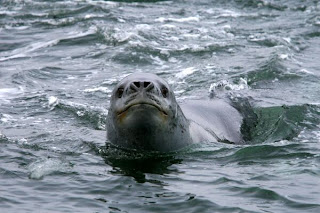

Kirsten and I were standing on the ice foot on the beach, a good 6 feet off the surface of the water, when Leopold came to check us out - he popped his head out of the water right under our feet, stared us in the eye, sniffed the air, and soon lost interest, swimming off in search of more palatable and accessible prey. Being scrutinized by a 10-foot predator was enough to raise the hair on the back of my head. I also had a keen awareness of how easily the tables could have turned had we been in the water alongside him, though I'm not sure which would be worse: -1.8 degree water or an overly curious leopard seal?
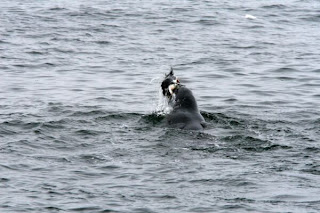
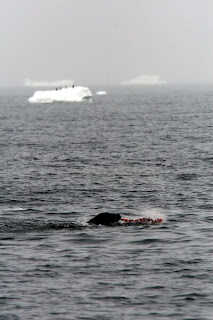
Penguins stand around for hours along the shore or at the edge of ice floes waiting for enough critical mass before taking the group plunge into the icy water. Leopard seals have trouble catching penguins in open water, and they are useless predators when hauled out, but they lurk in the water at the transition between ice and sea, or land and sea as the case may be, waiting for a disoriented penguin to slow down enough before jumping in or out. "Safety in numbers" is penguin-at-sea rule #1.

"Jump high" is rule #2. Bouncing off the ice edge and back into the water could have very dire consequences. This penguin had a hard landing, but at least he was safe from Leopold's reach.

Another Adelie undecidedly surfs a small ice chunk before diving in alone.
How Google Saved The Day In Antarctica
It's been a busy week! Last week we had a second storm that kept us in for a day, and we've been playing endless catchup whenever we get a day down in the colony. Yesterday we hiked to the stone igloo, the only remaining testament to the aptly titled mid-winter journey from "The Worst Journey in The World," the tale of Robert Falcon Scott's last expedition to Antarctica in 1911. During their first winter three men (Edward Wilson, Birdie Bowers, and Apsley Cherry-Garrard, who wrote the book) set out to Cape Crozier on foot and sledge, a 70 mile journey in the dark. They endured extreme cold, frost-bite, starvation, and near-death so they could be the first to collect emperor penguin eggs from the colony at Cape Crozier. The "igloo" looks more like a ring of rocks filled with the tatters of the nearly failed expedition: penguin parts, shreds of canvas, wind-worn wool clothing, a test tube, rope, and rusted tin cans, all perfectly preserved by the Antarctic cold.We hiked under a perfect blue sky for 2 hours. As we rose over the last knoll we noticed that a heavy fog lay ahead, concealing the spur of rocks where the three men chose to build their makeshift shelter. We were soon distracted by a multitude of rare green lichens thriving in the lee of rocks and cracks, and by the time we looked up again the fog had erased all landmarks. We walked in circles for a couple of hours but finally decided we had no idea where the igloo was when we ventured onto a snowfield and found ourselves completely suspended in white, no rocks in sight, the sky and snow merged into unified white flatness, our jackets, hats, and hair outlined in hoarfrost. Fortunately we had GPS units and a satellite phone. We needed to call someone with good computer skills and access to Google. Hugh rang up a friend and dictated the Google search terms over the shaky, time-delayed connection: "stone," "igloo," "crozier," "aspa" (for Antarctic Specially Protected Area), and "gps coordinates." Within seconds she found the prized numbers, we plugged them into Grant's GPS unit, and the five of us trudged towards our invisible goal with renewed confidence. It was only 1,000 meters from where we had made the call. Wandering in the all-concealing fog was probably not unlike what Wilson, Bowers, and Cherry-Garrard had to deal with when navigating in the dark, but we were blessed with considerably warmer temperatures and some very handy technological gadgets.We got home at 11:30 PM. Kirsten cooked a quick, delicious dinner, and then I was so completely exhausted that I forgot to call my family in Italy, who at that same hour were just gathering for their Christmas appetizers of freshly baked focaccia, local cheeses, and salame.Chris and Hugh are scheduled to leave today. They've been documenting their week at Cape Crozier each day with great stories and photos. Check it out here (see December 19-25).
The fog that lay ahead. Igloo spur is to the right of and below the Knoll, which rises above the fog.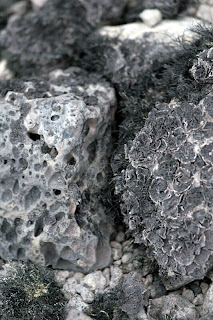 Usnea and Umbilicaria, the lichens that swayed us from our path.
Usnea and Umbilicaria, the lichens that swayed us from our path.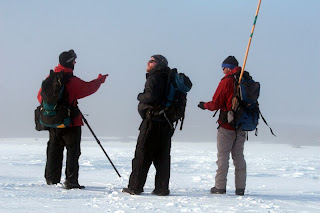 Chris, Hugh and Grant in the fog.
Chris, Hugh and Grant in the fog.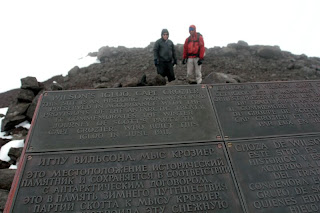 Hugh and Grant at the stone igloo.
Hugh and Grant at the stone igloo. Tattered remnants in the igloo: an emperor penguin skin, shreds of green faded canvas, an old box.
Tattered remnants in the igloo: an emperor penguin skin, shreds of green faded canvas, an old box.
A Crowded Place
Last week we had Roger, Jess, and Ryan, who made it out of Crozier just in time before a wind storm swept in and kept us indoors for 4 days. Yesterday we were joined by a team of two from the Woods Hole Oceanographic Institute - photographer Chris Linder and science writer Hugh Powell. They will be here for a week documenting life and penguins at Cape Crozier. You can see Chris' beautiful photography and read Hugh's Antarctic tales on the WHOI Polar Discovery site (scroll down to December 19th and after). The hut is always livelier with 5 people!
Year of the Wind
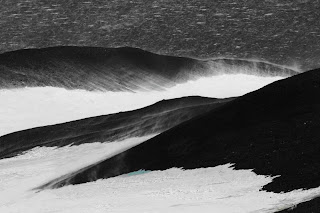 Windy view from the hut (photo by Kirsten)kat•a•bat•ic - adj. Meteorol. (of a wind or air current) moving downward or down a slope. Cf. anabatic (def. 1) [1915–20; <>
Windy view from the hut (photo by Kirsten)kat•a•bat•ic - adj. Meteorol. (of a wind or air current) moving downward or down a slope. Cf. anabatic (def. 1) [1915–20; <>
Hut day #4. The wind has been oscillating between gale force (32–63 mph) and storm force (64–72 mph) since Friday, with occasional forays into hurricane force (>72 mph). We kill time by searching for adjectives for wind: howling, blowing, whistling, blustery, raging, tearing, blasting, gusting, slashing, furious, maddening, screaming, shrieking, whooshing. From the hut it sounds like a soft whoosh, a slight whistle, a large breath through the heater vent. From the tent it howls, blows, and ululates, flapping and snapping the tent canvas like a mad animal (there are no land mammals in Antarctica, but when the wind picks up the tent ropes and fabric make sounds like small animals scurrying around the rocks just outside the tent - we call them the toothy scrapers). When you are outside you don't hear the wind as much because you're so busy trying to stand upright as it pushes you around like a top. It's been windy like this, on and off, for the past month, delaying flights, keeping people inside, and exasperating everyone. Cape Crozier, as usual, is windier than everywhere else - the katabatic winds flow down from the cold, dry polar plateau, across the Ross Ice Shelf, and past Cape Crozier virtually unhindered, pusing out the sea ice and whipping up the surface of the water into foamy whitecaps and spindrift. Penguin life is mostly unaltered - they are shaped like small, heavy torpedoes, and don;t get blown off their nests until the wind goes above 120 mph.
My favorite wind words are for things shaped by the wind: ventifacts, rocks that have been faceted, grooved, and polished by wind-driven sand; sastrugi, ridges of wind-carved snow; spindrift, spray swept by a violent wind along the surface of the sea; anemosis, a flaw in wood caused by the action of strong winds upon the tree trunk; yardang, a keel-shaped crest or ridge of rock formed by the action of the wind.

Lenticular cloud shaped like a squid, announcing high winds (photo by Grant)

Snow petrels love to fly in big winds
The Most Beautiful Place In The World
I finally made it! I'm at Cape Crozier, my most favorite place in the world. Flew here on Monday with Ryan Miller, Jessica Reynolds, and Roger Hill, who are visiting for the week. Ryan and Jessica are here filming on an artists and writers grant and will fly out tomorrow. Roger runs Wildlife Computers and was here to see how we use his tags on penguins. He left yesterday. Grant and Kirsten have been here for about three weeks and already seem well-tempered by the Antarctic elements. The weather is gorgeous, penguin chicks are hatching, and the field season is in full swing! But today I am hut-bound, studying for a statistics final exam tomorrow. At least I get to listen to the skuas laughing outside instead of the San Francisco street traffic.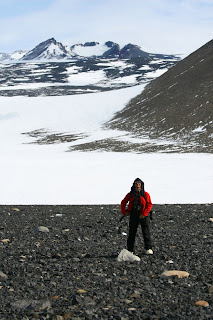 Roger Hill at the foot of Mt. Terror
Roger Hill at the foot of Mt. Terror First day, hike to the emperor penguin colony
First day, hike to the emperor penguin colony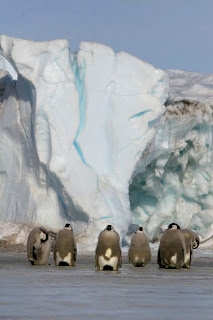 Emperor penguin chicks
Emperor penguin chicks
Still at McMurdo...
I'm still here! Yesterday's flight was delayed until today which is delayed until tomorrow. I spoke to Grant by radio tonight and he says a storm is brewing at Cape Crozier, so I could very well be at McMurdo for another few days. This place if full of scientists, artists, geeks, world travelers, and other talented geniuses, so despite its ex-military squalor it's not such a bad place to be stuck for a few days. Between one wine bar, strange machinery, cool scientific gizmos, spectacular scenery, and a crowd of people full of interesting tales there is always some way to fill one's time here ...  Bob Zook with SCINI, the skinny ROV (Remotely Operated Vehicle)
Bob Zook with SCINI, the skinny ROV (Remotely Operated Vehicle)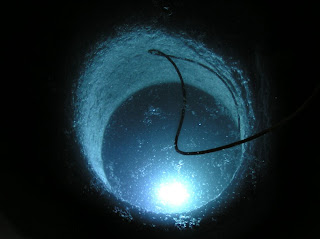 SCINI in the ice hole, ready for action
SCINI in the ice hole, ready for action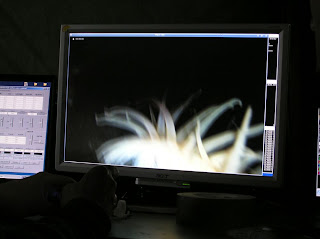 SCINI, which is operated from this workstation, spies a sea anemone under the ice.
SCINI, which is operated from this workstation, spies a sea anemone under the ice.
I'm Back!
I arrived at McMurdo station yesterday, a gorgeous, sunny day. We flew over an endless expanse of pack ice - floes of all shapes and sizes pushed up against each other on a flat, steely ocean. Then it was mountains, and glaciers flowing from the frozen peaks into the frozen sea, and more pack ice along the coast. We landed the giant cargo plane on the immense flat whiteness of the Ross Ice Shelf, ringed by mountains and volcanoes, with the sun moving horizontally across a truly blue sky.McMurdo is packed to the gill - 1,100 people are here at the moment! Yet, despite so many people crowded into a small place, the town is still dwarfed by the immensity of the surrounding landscape, a tiny human speck in a place that defies all human scales. Here there is space to be, and anything superfluous becomes obvious and easy to cast aside. Life is so scarce at first glance that any evidence of it (a seal sleeping on the ice, a lichen, a sea creature showing off its bright pigments under the sea ice) is awe-inspiring, an admirable force ready for action against all odds.I'm supposed to fly to Cape Crozier tomorrow but it's snowing like crazy. I spoke to Grant via satellite phone and he said that our tent is completely buried in big, fluffy snow. We haven't seen each other in 5 weeks and I'm itching to get there, but in typical Antarctic fashion the weather may very well keep up apart for another few days. I'm not generally superstitious, but I swear that the more you care about getting somewhere around here the greater the chances that bad weather will keep you put. It's a harsh continent, as locals are fond of reminding each other. If all goes well, I'll be at Cape Crozier withing the next 1-5 days.On a totally different note, I just got word that Amelie and Valere, who were at Crozier with us last year, just had a baby boy. Congratulations you two! You hatched before the penguins chicks. We'll be sure to consume lots of chocolate crepes in your honor.Off to the wine bar!
 A rather fuzzy view of Antarctica...
A rather fuzzy view of Antarctica...















